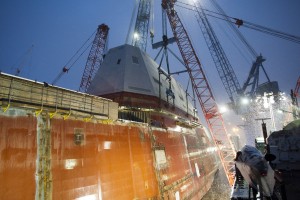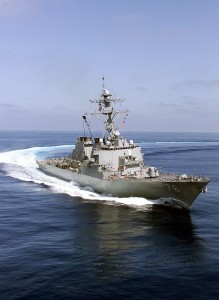 If the Trump Administration is going to build a 350-ship Navy, then Bath Ironworks will have a big role. I had a chance to talk with the Times Record’s Nathan Strout, and offered a few thoughts on the future fleet’s impact upon Bath Ironworks.
If the Trump Administration is going to build a 350-ship Navy, then Bath Ironworks will have a big role. I had a chance to talk with the Times Record’s Nathan Strout, and offered a few thoughts on the future fleet’s impact upon Bath Ironworks.
There’s some skepticism out there about the 350-ship goal. Let me end that right now–It’s gonna happen. First, the 350-ship target has already been well-socialized throughout DC. I’ve been a part of some of these discussions, and, frankly, I’m pretty OK with the various blueprints that will be released over the coming months–they’re not perfect, but they’re all pretty darn reasonable. And given the demonstrated political will out there and the likely naval leaderships team, well…as far as I am concerned, the numbers argument is done, a hopeless exercise for some bitter-ender deficit-hawks:
“Over the past few months a 350-ship Navy has been something of a consensus target in quiet think-tank discussions throughout DC, so the target is sensible,” said Craig Hooper…”
Now, most of the studies out there take a leisurely, decades-long route to 350. That’s not going to work. The Trump Team made that 350-ship number a central feature–one of very few bogies the Administration made for itself–so, with that in mind, the Trump White House will want their 350-ships sooner rather than later.
350 ships must be in the fleet within four years.
Period.
As I noted in an earlier post, a 350-ship Navy can be completed quickly, allowing the Trump Administration to claim an early success, BUT the ersatz Navy I describe in my post wouldn’t have real sticking power–it’d be largely a symbolic demonstration of political commitment.
The Trump Administration may stop there, but I’d sure sleep better if a rapid, “see what we can do” naval expansion to 350 was coupled with a longer-term plan to build and project a 350-ship Navy over the longer-term. As I said in the article:
“The decades it takes to get to a 350-ship fleet may not be acceptable if the Trump Administration is focused on meeting this goal before the next election,” said Hooper. “There’s still a lot of uncertainty, and the Trump Administration is doing a very good job of keeping their options open. But the outlook for Bath is positive if the Trump Administration resists the temptation to grow the fleet exclusively using bureaucratic chicanery and other short-term fleet-boosting measures. I expect the Trump Administration to rely on a healthy mix of long-term and short-term solutions to grow the fleet.”
 Now, Steve Forbes (the consensus candidate for SECNAV) is savvy enough to manage both objectives as the Navy chief. If Forbes is allowed to look to the longer-term–and build a larger Navy for the future-then Bath Ironworks is in pretty good shape for survival. As I discussed here, competing with Ingalls for DDG-51 work won’t be pretty, and Bath may not be hugely profitable, but it won’t go out of business either.
Now, Steve Forbes (the consensus candidate for SECNAV) is savvy enough to manage both objectives as the Navy chief. If Forbes is allowed to look to the longer-term–and build a larger Navy for the future-then Bath Ironworks is in pretty good shape for survival. As I discussed here, competing with Ingalls for DDG-51 work won’t be pretty, and Bath may not be hugely profitable, but it won’t go out of business either.
Now, I think it will be critical for shipyards to avoid cost and schedule growth during the first four years of the Trump Administration. I am fairly certain the Trump Administration would relish the political theatre in killing off a defense program or two.
No shipyard wants the become Trump’s poster-child for Pentagon Waste, so, to avoid that fate:
“If the Trump Administration is serious about growing the fleet, starting a deliberate, decades-long expansion, then Bath is going to be in great shape,” said Hooper. “It is critical that the next-generation Flight III Arleigh Burke gets either sped into production or a few additional “restart” destroyers — the ones already in production at Bath–are added while the design is finalized.”
Put off the Flight III DDG-51s. I’d urge Navy stakeholders to try and add on some Flight IIa before jumping into the Flight IIIs. Bath’s getting the dubious honor of building the first Flight III DDG-51. It’s not going to be a fun experience for anybody, and a fracas over design or a delay could really hurt Bath. So add some more Flight IIa “tech inserts” or some FMS deals (cough you know who you are cough cough)–whatever is needed to give Bath time to get up to speed on DDG-Flight III.
Now, there’s some new rumblings about the DDG-1000 over at CNBC, here. Ben Freeman is back, replaying–as I wrote in 2015–his role as DC’s erstwhile DDG-1000 fan. Here’s what Ben’s saying at CNBC:
“My concern is that the Trump administration … would continue to buy the antiquated technology just to get ships in slots to that 350 number,” said Freeman, a long-term proponent of the Zumwalt class.
While the upfront costs of the Zumwalt-class destroyers are higher, Freeman contends there’s a longer-term savings for the Navy going with the next-generation warships over the older Arleigh Burke-class. He insists the lifetime costs of going with newer-class destroyer technology is “at least equal” if not ultimately lower than the older class.
“If you can pay a little money now to get a better ship, then that will be cheaper to operate in the long run and we should do that,” said Freeman. Moreover, he said he expects the Navy will eventually lower the cost of the 155-millimeter projectiles and can increase the use of Zumwalt’s laser electric weaponry.
I can see why Bath could want to keep building DDG-1000–they invested a ton of money into the yard to make Bath THE yard for the DDG-1000 hull-form. It’s the only hull where Bath has a distinct advantage over Ingalls (Ingall’s multi-billion dollar composite DDG-1000 deckhouse is not going to age well!), and if the DDG-1000 production line did survive long enough to get the hull into serial production, Bath would have a real chance at winning the next-gen air-defense cruiser contest.
But I don’t know if Bath can beat the LPD-17 hull-form for that “big surface combatant” mission. LPD-17 took decades to “get ready” for follow-on variants, and I don’t think Bath has time to work the kinks out of the DDG-1000 before the hulls are going to be needed. Depending on what President Trump wants to do, America may not have the luxury of taking decades to refine and fix ambitious technological “leaps”–meaning that Bath will probably need to make it’s peace with DDG-51 business, focusing on winning the “competitions” with Ingalls or working some scheme with the government to have Ingalls “load shed” DDG-51s to Bath as a raft of high-priority amphib and big flat-deck work rolls into HII.
It may be time to build what we have, and bulk up for confrontation.
We’ll see.
